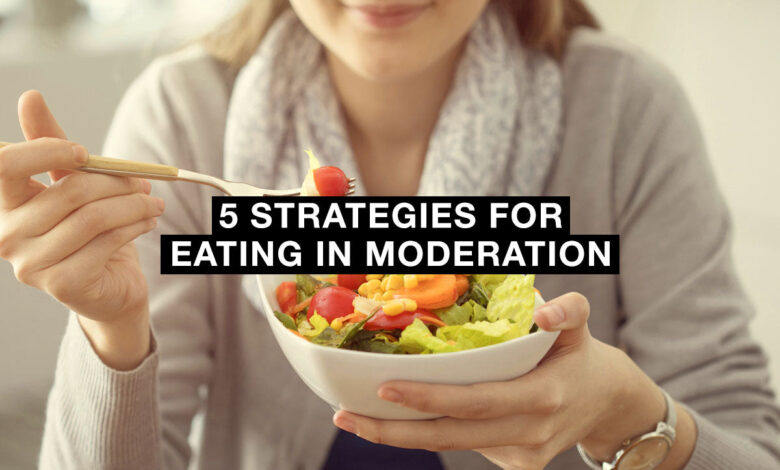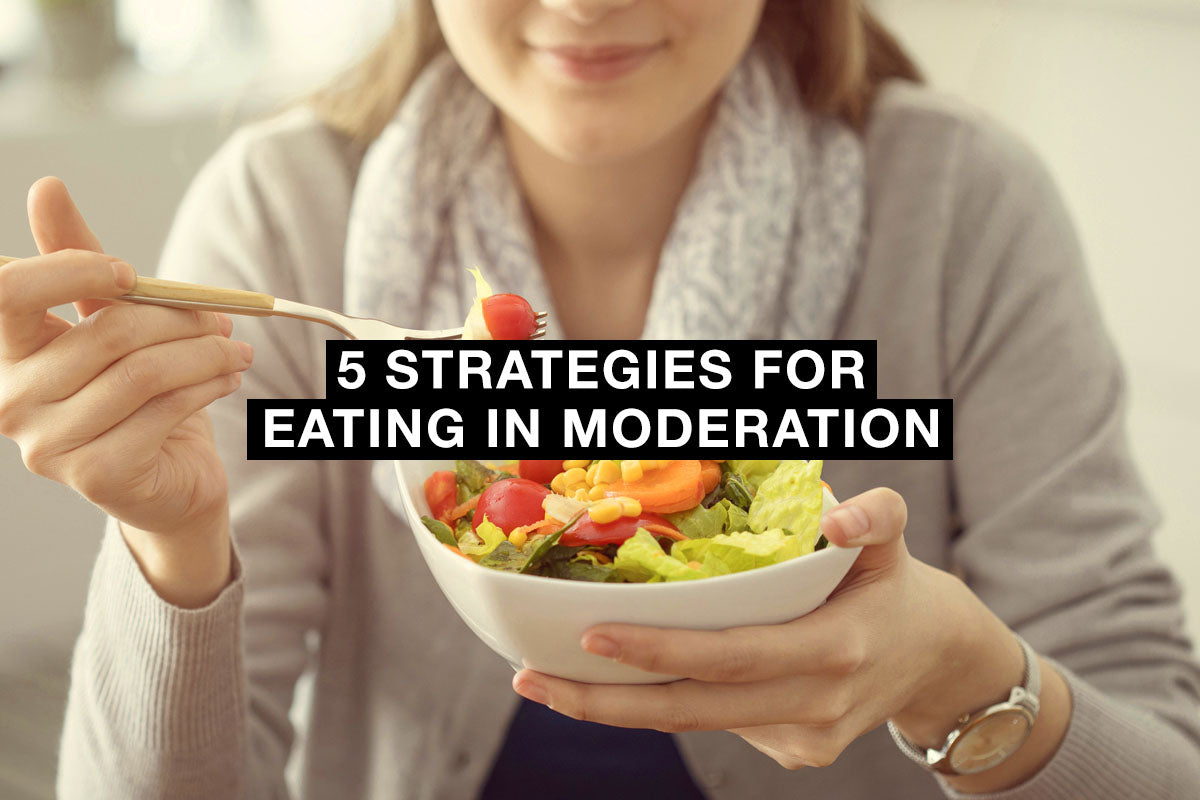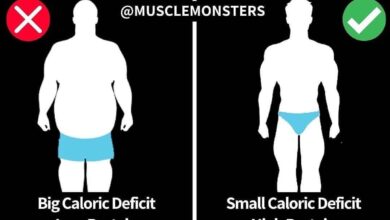
Strategies for Eating in Moderation: A Guide to Healthy Habits
Navigating the world of food can be a challenge, especially when it comes to finding the right balance. Strategies for eating in moderation are not just about restricting calories, but about developing a mindful and healthy relationship with food.
This approach allows you to enjoy your favorite foods without feeling deprived, while prioritizing your overall well-being.
This guide will delve into various aspects of mindful eating, from understanding your individual needs to incorporating physical activity into your routine. We’ll explore practical tips and techniques that can help you achieve sustainable moderation, promoting a healthier lifestyle and a happier you.
Understanding Moderation
Moderation in eating is a key aspect of a healthy lifestyle, promoting both physical and mental well-being. It involves consuming food in a balanced way, avoiding overindulgence while ensuring adequate nourishment. By understanding the benefits and risks associated with eating habits, you can create a personalized plan that supports your health goals.
Benefits of Eating in Moderation
Eating in moderation offers a wide range of benefits for your overall health. It helps maintain a healthy weight, reduces the risk of chronic diseases, and promotes energy levels and mental clarity.
- Weight Management:Consuming a balanced diet with appropriate portion sizes helps maintain a healthy weight, reducing the risk of obesity and associated health problems like type 2 diabetes, heart disease, and certain cancers.
- Reduced Risk of Chronic Diseases:Overeating and consuming excessive amounts of unhealthy foods increase the risk of developing chronic diseases. Moderation helps lower the risk of heart disease, stroke, type 2 diabetes, and some types of cancer.
- Improved Energy Levels:A balanced diet provides your body with the nutrients it needs to function optimally. Eating in moderation ensures you receive adequate energy without feeling sluggish or experiencing energy crashes.
- Enhanced Mental Clarity:A healthy diet supports brain function and cognitive health. Moderation helps maintain blood sugar levels, promoting mental clarity, focus, and mood stability.
Risks of Overeating and Undereating
Both overeating and undereating can have detrimental effects on your health. It’s crucial to find a balance that meets your individual needs.
- Overeating:Overconsumption of calories and unhealthy foods can lead to weight gain, increased risk of chronic diseases, digestive problems, and nutritional deficiencies.
- Undereating:Insufficient calorie intake can lead to fatigue, weakness, nutrient deficiencies, and a weakened immune system. In severe cases, it can also lead to eating disorders.
Creating a Personalized Moderation Plan
Finding the right balance for your needs requires self-awareness and understanding of your eating habits.
- Identify Your Individual Needs:Consider your age, activity level, health conditions, and dietary preferences. Consult with a healthcare professional or registered dietitian to determine your specific nutritional requirements.
- Track Your Food Intake:Keep a food diary for a few days to identify your current eating patterns and identify areas for improvement. This can help you understand your calorie intake, portion sizes, and food choices.
- Set Realistic Goals:Start with small, achievable changes. Focus on gradually incorporating healthier choices and reducing unhealthy habits rather than making drastic overhauls.
- Listen to Your Body:Pay attention to your hunger and fullness cues. Eat when you’re truly hungry and stop when you feel comfortably full. Avoid eating out of boredom, stress, or emotional triggers.
- Practice Mindful Eating:Slow down your eating pace, savor each bite, and focus on the taste and texture of your food. This can help you feel more satisfied with smaller portions and prevent overeating.
Mindful Eating Practices
Mindful eating is a powerful tool for achieving and maintaining a healthy weight. It involves paying close attention to your body’s hunger and fullness cues, savoring your food, and eating without distractions.
Strategies for eating in moderation are all about finding that sweet spot where you feel satisfied without overdoing it. One helpful approach is to focus on eating for fullness and satisfaction, which can help you naturally manage your intake.
Check out this article for an RD-approved approach to eating for fullness and satisfaction: an rd approved approach to eating for fullness and satisfaction. By prioritizing quality over quantity and listening to your body’s cues, you can develop a sustainable strategy for moderation that supports both your physical and mental well-being.
Paying Attention to Hunger and Fullness Cues
It’s important to understand the difference between true hunger and emotional or boredom eating. When you’re truly hungry, your stomach will rumble, and you may feel lightheaded or weak. Emotional eating, on the other hand, is often triggered by stress, boredom, or sadness.
Learning to recognize these cues can help you make more conscious choices about when and what you eat.
Step-by-Step Guide to Mindful Eating
Mindful eating is a practice that can be cultivated over time. Here’s a step-by-step guide to help you get started:
- Choose a quiet place to eat.Turn off the TV, put away your phone, and focus on your meal.
- Take a few deep breaths before you start eating.This will help you relax and be more present in the moment.
- Pay attention to the appearance, aroma, and texture of your food.Notice the colors, shapes, and details of your meal. Take a moment to appreciate the flavors and aromas.
- Eat slowly and savor each bite.Put your fork down between bites and chew your food thoroughly. Allow yourself to taste the different flavors and textures.
- Check in with your hunger and fullness levels throughout the meal.Ask yourself: “Am I still hungry?” or “Am I feeling full?”
- Stop eating when you’re comfortably full.Don’t force yourself to finish everything on your plate. Listen to your body’s signals and stop when you feel satisfied.
- Practice mindful eating at every meal.The more you practice, the easier it will become to be present and aware of your eating habits.
Mindful Eating Practices in Daily Life
Mindful eating can be incorporated into your daily life in many ways. Here are some examples:
- Eat without distractions.Turn off the TV, put away your phone, and focus on your meal.
- Practice mindful snacking.If you’re going to snack, choose healthy options and eat them mindfully.
- Listen to your body’s hunger and fullness cues.Don’t eat just because it’s mealtime or because food is available. Only eat when you’re truly hungry.
- Savor your food.Take your time to eat and enjoy the flavors and textures of your meal.
- Be kind to yourself.Mindful eating is a journey, not a destination. Don’t beat yourself up if you slip up. Just get back on track and continue practicing.
Portion Control Strategies
Portion control is a crucial aspect of eating in moderation. It involves consuming appropriate quantities of food, helping you manage your calorie intake and prevent overeating. By understanding and practicing portion control, you can achieve a healthy weight, improve your overall well-being, and enjoy a balanced diet.
Estimating Portion Sizes Without Measuring Tools
Estimating portion sizes accurately without relying on measuring tools can be challenging. However, with a little practice and some helpful visual cues, you can become proficient in gauging the right amount of food. Here are some practical tips to estimate portion sizes:
- Use your hand as a guide: Your hand can serve as a handy visual aid for estimating portions. For instance, a fist-sized portion is roughly equivalent to one cup of cooked pasta or vegetables. Your palm can represent a 3-ounce portion of meat or fish, while your thumb tip represents one tablespoon of peanut butter or salad dressing.
One of the key strategies for eating in moderation is understanding how to prepare food from scratch. Mastering basic cooking skills, like sautéing, roasting, and steaming, allows you to control the ingredients and portion sizes, ultimately leading to healthier choices.
If you’re looking to expand your culinary repertoire, check out this article on essential cooking skills everyone should master for a great starting point. This knowledge empowers you to make informed decisions about your food choices, leading to a more balanced and mindful approach to eating.
- Utilize everyday objects: Common household items can help visualize portion sizes. For example, a deck of cards is roughly the size of a 3-ounce serving of meat or fish. A tennis ball can represent a 1-cup portion of cooked rice or pasta.
- Focus on visual cues: Pay attention to the size and shape of your food. For example, a serving of fruit is about the size of a tennis ball. A portion of vegetables should be the size of your fist.
Visual Examples of Portion Sizes
Here’s a table showcasing visual examples of portion sizes for different food groups:
| Food Group | Portion Size | Visual Example |
|---|---|---|
| Fruits | 1 medium fruit | Apple, orange, banana |
| Vegetables | 1 cup | Broccoli, spinach, carrots |
| Grains | 1/2 cup cooked | Rice, pasta, quinoa |
| Protein | 3 ounces | Chicken breast, fish, tofu |
Healthy Food Choices: Strategies For Eating In Moderation
Making smart food choices is crucial for maintaining a healthy weight and overall well-being. Choosing nutrient-dense foods over processed and calorie-laden options can provide essential vitamins, minerals, and fiber while keeping your calorie intake in check.
The Importance of Nutrient-Dense Foods
Nutrient-dense foods are packed with essential nutrients, such as vitamins, minerals, and fiber, in relation to their calorie content. These foods provide a wide range of health benefits, including supporting a strong immune system, regulating blood sugar levels, and promoting healthy digestion.
They also contribute to satiety, helping you feel fuller for longer and reducing the likelihood of overeating.
Key Food Groups and Their Contributions to Overall Health
A balanced diet should include a variety of foods from all food groups. Each group provides unique nutrients that contribute to overall health.
- Fruits:Rich in vitamins, minerals, and antioxidants, fruits provide essential nutrients that support a healthy immune system, protect against chronic diseases, and promote healthy digestion. Examples include apples, bananas, berries, oranges, and grapefruits.
- Vegetables:Packed with vitamins, minerals, fiber, and antioxidants, vegetables are essential for maintaining a healthy weight, regulating blood sugar levels, and supporting a strong immune system. Examples include broccoli, spinach, carrots, tomatoes, and leafy greens.
- Grains:Whole grains are a good source of fiber, B vitamins, and minerals. They help regulate blood sugar levels, promote digestive health, and provide sustained energy. Examples include brown rice, quinoa, oatmeal, and whole-wheat bread.
- Protein:Protein is essential for building and repairing tissues, supporting a healthy immune system, and regulating hormones. Lean protein sources include fish, poultry, beans, lentils, and tofu.
- Dairy:Dairy products are a good source of calcium, vitamin D, and protein. They contribute to strong bones and teeth, support muscle function, and promote healthy blood pressure. Examples include milk, yogurt, and cheese.
Healthy Food Swaps
Making smart food swaps can help reduce calorie intake without sacrificing flavor or satisfaction. Here are some healthy substitutions to consider:
- Swap sugary drinks for water, unsweetened tea, or sparkling water with a squeeze of lemon or lime.Sugary drinks are a major source of empty calories and can contribute to weight gain and other health problems.
- Choose whole-grain bread over white bread.Whole-grain bread is a good source of fiber, which can help you feel fuller for longer and regulate blood sugar levels.
- Opt for grilled or baked chicken or fish instead of fried options.Fried foods are high in calories and unhealthy fats, which can contribute to weight gain and heart disease.
- Use olive oil or avocado oil instead of butter or margarine.Olive oil and avocado oil are healthy fats that can help lower cholesterol levels and reduce the risk of heart disease.
- Choose fresh or frozen fruits and vegetables instead of canned or processed options.Canned and processed fruits and vegetables often contain added sugar, salt, and unhealthy fats.
- Swap regular yogurt for Greek yogurt.Greek yogurt is lower in sugar and higher in protein, making it a more nutritious choice.
- Choose air-popped popcorn over chips or pretzels.Popcorn is a whole-grain snack that is low in calories and a good source of fiber.
- Replace sugary cereal with oatmeal or whole-grain breakfast cereal.Oatmeal and whole-grain cereal are good sources of fiber and can help you feel fuller for longer.
Meal Planning and Preparation
Meal planning can be a powerful tool for maintaining moderation in your eating habits. By taking the time to plan your meals in advance, you can make healthier choices and avoid impulsive snacking.
Benefits of Meal Planning, Strategies for eating in moderation
Meal planning can help you achieve your weight management goals by promoting mindful eating and portion control.
- Reduces impulsive snacking:By having healthy meals and snacks readily available, you’re less likely to reach for unhealthy options when hunger strikes.
- Encourages mindful eating:Planning your meals allows you to make conscious decisions about what you eat, helping you stay focused on your goals.
- Promotes portion control:When you prepare your meals in advance, you can control the portion sizes, preventing overeating.
- Saves time and money:Planning your meals can help you save time and money by reducing the number of times you need to shop and cook.
- Reduces food waste:By planning your meals, you can use up ingredients before they spoil, reducing food waste.
Sample Meal Plan
Here’s a sample meal plan for a week that incorporates portion control and healthy food choices. Remember to adjust the portions and ingredients based on your individual needs and preferences.
Monday
- Breakfast:Oatmeal with berries and nuts (1 cup oatmeal, 1/2 cup berries, 1/4 cup nuts)
- Lunch:Salad with grilled chicken or fish (1 cup salad greens, 4 oz grilled chicken or fish, 1/2 cup vegetables)
- Dinner:Baked salmon with roasted vegetables (4 oz salmon, 1 cup roasted vegetables)
- Snack:Fruit (1 medium piece of fruit)
Tuesday
- Breakfast:Greek yogurt with fruit and granola (1 cup Greek yogurt, 1/2 cup fruit, 1/4 cup granola)
- Lunch:Leftover salmon with salad (1 cup salad greens, 1/2 cup vegetables)
- Dinner:Lentil soup with whole-wheat bread (1 cup lentil soup, 1 slice whole-wheat bread)
- Snack:Vegetable sticks with hummus (1/2 cup vegetable sticks, 2 tablespoons hummus)
Wednesday
- Breakfast:Whole-wheat toast with avocado and egg (2 slices whole-wheat toast, 1/4 avocado, 1 egg)
- Lunch:Chicken wrap with vegetables (4 oz chicken, 1 whole-wheat tortilla, 1/2 cup vegetables)
- Dinner:Chicken stir-fry with brown rice (4 oz chicken, 1 cup vegetables, 1/2 cup brown rice)
- Snack:Trail mix (1/4 cup trail mix)
Thursday
- Breakfast:Smoothie with fruit, yogurt, and spinach (1 cup fruit, 1/2 cup yogurt, 1 cup spinach)
- Lunch:Leftover chicken stir-fry with salad (1 cup salad greens, 1/2 cup vegetables)
- Dinner:Vegetarian chili with cornbread (1 cup vegetarian chili, 1 slice cornbread)
- Snack:Cottage cheese with fruit (1/2 cup cottage cheese, 1/4 cup fruit)
Friday
- Breakfast:Pancakes with fruit and syrup (2 pancakes, 1/2 cup fruit, 2 tablespoons syrup)
- Lunch:Tuna salad sandwich on whole-wheat bread (4 oz tuna, 2 slices whole-wheat bread, 1/2 cup vegetables)
- Dinner:Pizza with vegetables (1/2 pizza with vegetables)
- Snack:Popcorn (1 cup air-popped popcorn)
Saturday
- Breakfast:Eggs with whole-wheat toast and avocado (2 eggs, 2 slices whole-wheat toast, 1/4 avocado)
- Lunch:Out to eat (choose a healthy option)
- Dinner:Pasta with marinara sauce and vegetables (1 cup pasta, 1/2 cup marinara sauce, 1 cup vegetables)
- Snack:Dark chocolate (1 ounce dark chocolate)
Sunday
- Breakfast:Waffles with fruit and syrup (2 waffles, 1/2 cup fruit, 2 tablespoons syrup)
- Lunch:Leftover pasta with salad (1 cup salad greens, 1/2 cup vegetables)
- Dinner:Roasted chicken with potatoes and vegetables (4 oz chicken, 1 cup potatoes, 1 cup vegetables)
- Snack:Yogurt parfait (1/2 cup yogurt, 1/4 cup granola, 1/4 cup fruit)
Tips for Preparing Meals in Advance
- Cook in bulk:Prepare large batches of meals or ingredients that can be used throughout the week. For example, roast a whole chicken, make a big pot of soup, or cook a large batch of quinoa.
- Use leftovers:Repurpose leftovers into new dishes. For example, leftover chicken can be used in salads, wraps, or stir-fries.
- Prepare snacks:Keep healthy snacks readily available, such as fruits, vegetables, nuts, and yogurt. This will help you avoid impulsive snacking.
- Pack lunches:Pack your lunches the night before to save time in the morning. This will also help you make healthier choices and avoid eating out.
Addressing Emotional Eating
Emotional eating is a common coping mechanism for stress, boredom, or sadness. It can be a challenging habit to break, but with awareness and strategies, it’s possible to regain control over your eating habits.
Identifying Common Triggers
Understanding what triggers your emotional eating is the first step to managing it. Triggers can vary from person to person, but some common ones include:
- Stress: High-pressure situations, deadlines, or personal problems can lead to emotional eating.
- Boredom: When you’re feeling unengaged or lack stimulation, you might turn to food for entertainment.
- Loneliness: Social isolation or feelings of being alone can trigger emotional eating.
- Negative Emotions: Sadness, anger, anxiety, or frustration can prompt you to seek comfort in food.
Strategies for Managing Triggers
Once you identify your triggers, you can start implementing strategies to manage them:
- Mindfulness:Practice paying attention to your thoughts, feelings, and sensations without judgment. This can help you recognize when you’re emotionally hungry and choose a healthier response.
- Delaying Tactics:Give yourself a 20-minute delay before giving in to emotional eating. During this time, engage in a distraction activity like exercise, journaling, or spending time with loved ones.
- Healthy Alternatives:Instead of reaching for unhealthy comfort foods, try alternative activities like taking a walk, listening to music, or calling a friend. These can provide a similar sense of comfort without the negative consequences of emotional eating.
Self-Compassion and Reframing Negative Thoughts
Being kind to yourself is crucial in addressing emotional eating. Negative thoughts about food and your body can contribute to unhealthy eating patterns.
Finding strategies for eating in moderation can be a challenge, especially when you’re feeling uninspired. But just like a workout routine, it’s all about finding what works for you. Sometimes, a little change of pace is all you need.
If you’re struggling with your usual exercise routine, check out 8 fun ways to avoid home workout boredom for some fresh ideas. You might be surprised at how much energy you have for making healthy choices once you find a workout routine that you actually enjoy!
- Challenge Negative Thoughts:Recognize and challenge negative thoughts about food and your body. Ask yourself if these thoughts are realistic and helpful.
- Practice Self-Care:Engage in activities that promote self-care and well-being, such as exercise, relaxation techniques, or spending time in nature. These can help improve your mood and reduce the urge to emotional eat.
- Focus on Positive Aspects:Instead of dwelling on your failures, focus on your successes and progress. Celebrate your accomplishments and acknowledge your efforts to manage emotional eating.
Alternative Activities to Emotional Eating
Instead of turning to food for comfort, explore alternative activities that can provide a similar sense of satisfaction:
- Exercise:Physical activity releases endorphins, which can improve your mood and reduce stress. Choose activities you enjoy and that fit your fitness level.
- Journaling:Writing down your thoughts and feelings can help you process emotions and gain a better understanding of your triggers.
- Social Connection:Spending time with loved ones can provide emotional support and distraction from unhealthy cravings. Reach out to friends or family members for company and conversation.
- Creative Pursuits:Engaging in hobbies like painting, writing, or playing music can be a healthy outlet for your emotions and provide a sense of accomplishment.
Incorporating Physical Activity
Regular physical activity plays a crucial role in achieving and maintaining a healthy weight, complementing moderation in eating. By increasing your energy expenditure, exercise helps create a calorie deficit, making it easier to manage your overall calorie intake.
Moderate-Intensity Exercise Routines
Incorporating moderate-intensity exercise routines into your daily life can significantly contribute to your overall well-being. These routines can be as simple as brisk walking, cycling, swimming, or dancing, and can be easily integrated into your schedule.
- Brisk Walking:Aim for at least 30 minutes of brisk walking most days of the week. This can be broken down into shorter intervals, such as 10 minutes three times a day.
- Cycling:Cycling at a moderate pace for 30 minutes or more can provide a good cardiovascular workout. Choose a route that allows you to maintain a comfortable pace.
- Swimming:Swimming is a low-impact exercise that provides a full-body workout. Aim for at least 30 minutes of swimming at a moderate pace.
- Dancing:Dancing is a fun and enjoyable way to get exercise. Choose a dance style that you enjoy and that gets your heart rate up.
Benefits of Regular Exercise
Regular exercise offers numerous benefits for your overall health and well-being. It can:
- Help you maintain a healthy weight:Exercise burns calories and helps you maintain a healthy weight by increasing your metabolism.
- Reduce your risk of chronic diseases:Regular exercise can lower your risk of developing chronic diseases such as heart disease, stroke, type 2 diabetes, and some types of cancer.
- Improve your mood and mental health:Exercise releases endorphins, which have mood-boosting effects. It can also reduce stress and anxiety.
- Increase your energy levels:While it may seem counterintuitive, exercise can actually increase your energy levels by improving your cardiovascular health.
- Improve your sleep quality:Regular exercise can help you fall asleep faster and sleep more soundly.
Seeking Professional Guidance

Navigating the world of moderation can be challenging, and seeking professional guidance can be a valuable step in your journey. A registered dietitian or other qualified healthcare professional can provide personalized support and help you develop a sustainable plan that fits your individual needs and goals.
Finding a Qualified Professional
Finding a qualified professional is crucial for receiving accurate and effective guidance. Look for a registered dietitian (RD) or a licensed dietitian nutritionist (LDN), who are qualified to provide nutrition counseling and education. You can search for professionals in your area through the Academy of Nutrition and Dietetics website or other reputable organizations.
- Check credentials and experience:Ensure the professional is licensed and registered, and has experience working with individuals seeking to improve their eating habits.
- Read reviews and testimonials:Look for feedback from previous clients to get an idea of the professional’s approach and effectiveness.
- Schedule a consultation:Most professionals offer free consultations or initial assessments to discuss your goals and determine if they are a good fit for you.
Asking Relevant Questions
When you meet with a professional, ask clear and specific questions to ensure you understand their approach and the plan they recommend.
- What are your qualifications and experience in helping people with moderation?
- What are the benefits and risks of the approach you recommend?
- How will you tailor your recommendations to my specific needs and goals?
- What are the realistic expectations for progress?
- What are the costs associated with your services?
Benefits of Working with a Professional
Working with a registered dietitian or other qualified professional can provide numerous benefits, including:
- Personalized guidance:A professional can assess your individual needs, dietary habits, and health history to create a customized plan that addresses your specific concerns.
- Evidence-based strategies:They can provide you with evidence-based information and strategies for making sustainable changes to your eating habits.
- Accountability and support:Regular check-ins and ongoing support can help you stay motivated and accountable for your goals.
- Addressing underlying issues:A professional can help identify and address any underlying emotional or psychological factors that may be contributing to unhealthy eating patterns.
Conclusion
By embracing these strategies, you can transform your relationship with food, moving away from restrictive diets and towards a more balanced and fulfilling approach. Remember, moderation is not about perfection, but about progress. It’s about making small, sustainable changes that contribute to a healthier and happier you.






